Global Marketing Issues: Analysis and Reflection Report
VerifiedAdded on 2020/10/22
|12
|4700
|233
Report
AI Summary
This report provides a comprehensive analysis of global marketing issues, exploring key concepts such as leadership, ethics, and corporate social responsibility (CSR). It examines the impact of the digital environment on global marketing strategies, including the use of innovative technology and social media. The report includes reflections on articles related to leadership, ethics, and CSR, as well as the global marketing and digital environment, and innovative technology and social media. It also offers a module reflection, summarizing the key learnings and challenges encountered throughout the module. The report covers topics like leadership, ethics, CSR, global marketing, digital environment, innovative technology, and social media, and provides insights into how these concepts interact within a global context.
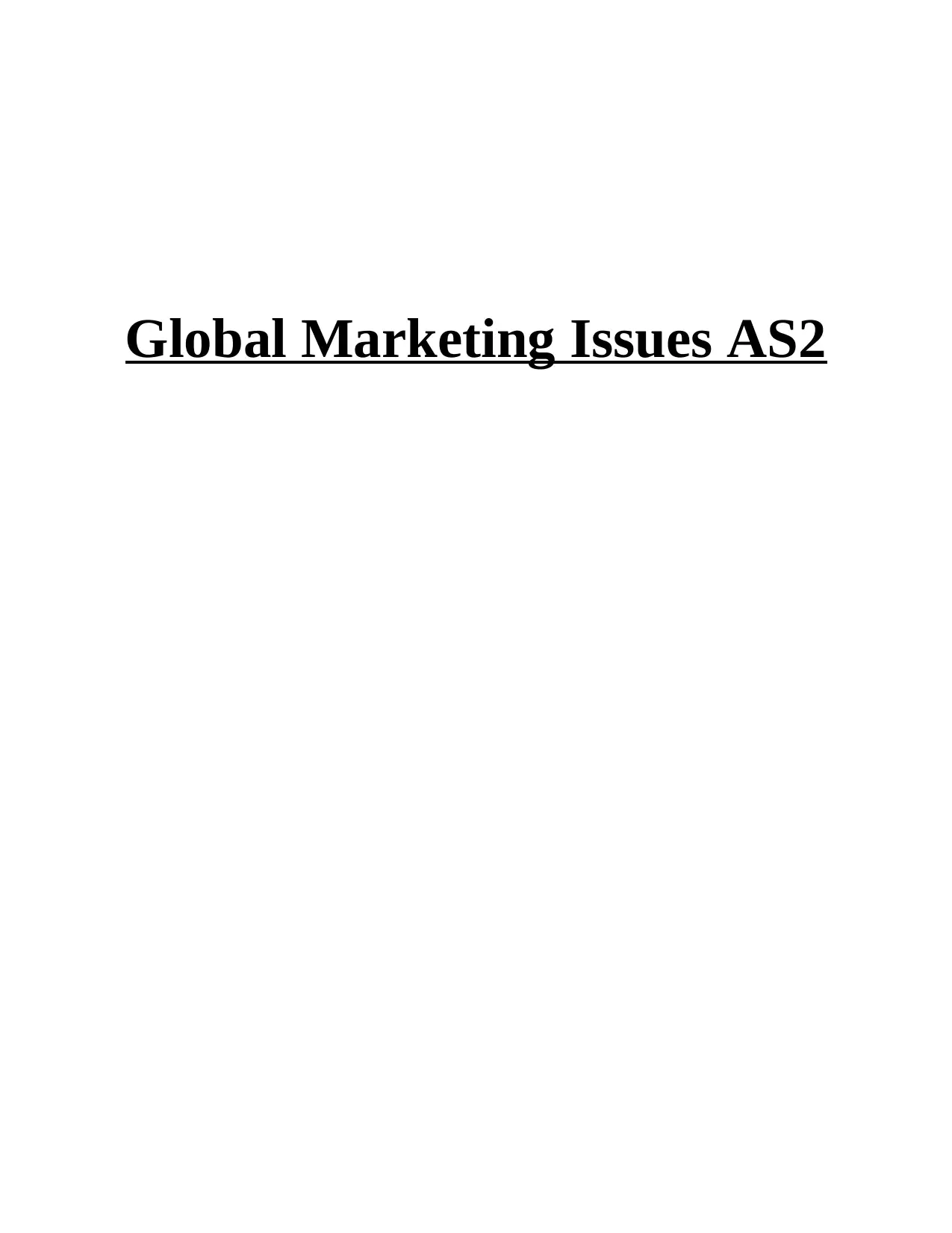
Global Marketing Issues AS2
Paraphrase This Document
Need a fresh take? Get an instant paraphrase of this document with our AI Paraphraser
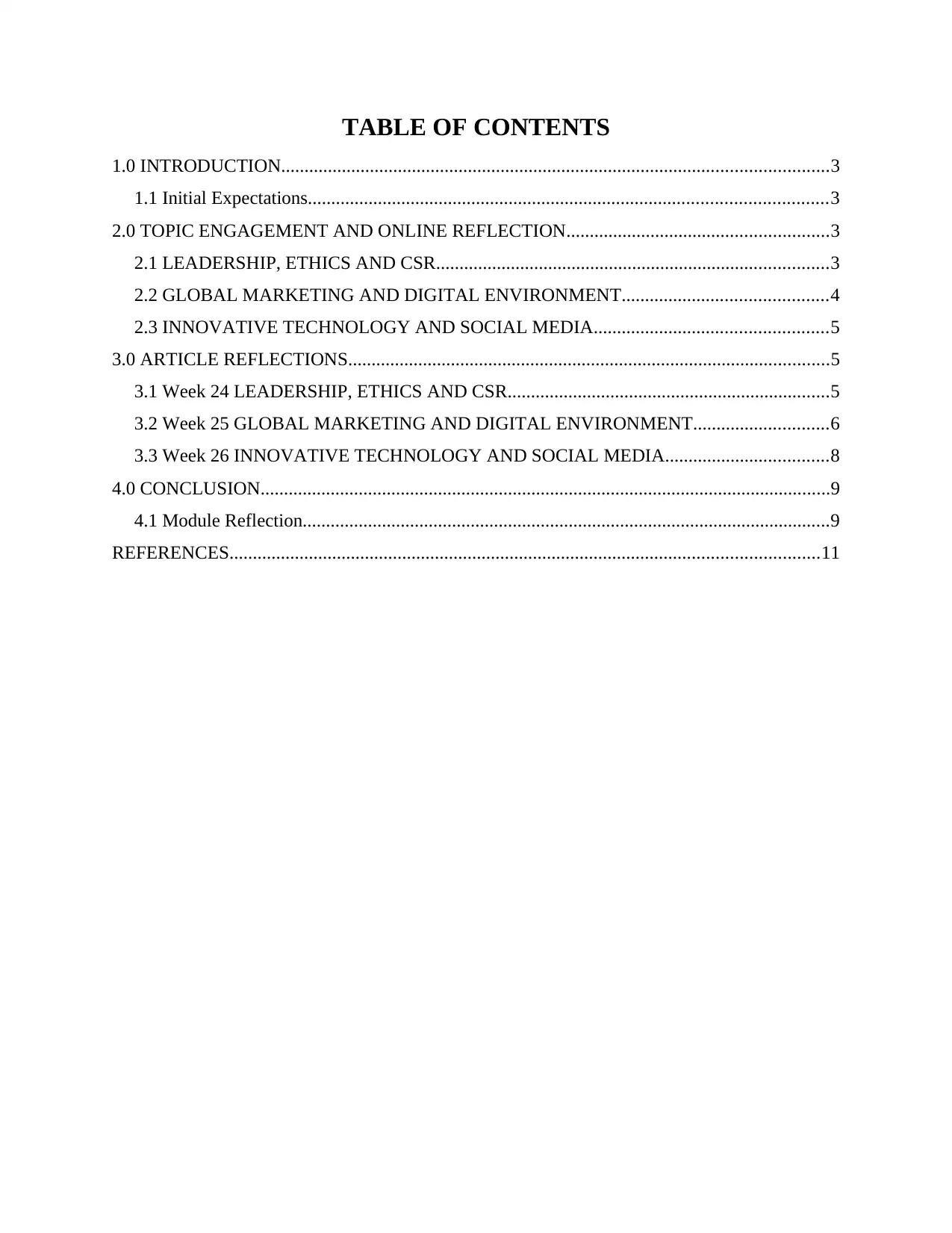
TABLE OF CONTENTS
1.0 INTRODUCTION.....................................................................................................................3
1.1 Initial Expectations...............................................................................................................3
2.0 TOPIC ENGAGEMENT AND ONLINE REFLECTION........................................................3
2.1 LEADERSHIP, ETHICS AND CSR....................................................................................3
2.2 GLOBAL MARKETING AND DIGITAL ENVIRONMENT............................................4
2.3 INNOVATIVE TECHNOLOGY AND SOCIAL MEDIA..................................................5
3.0 ARTICLE REFLECTIONS.......................................................................................................5
3.1 Week 24 LEADERSHIP, ETHICS AND CSR.....................................................................5
3.2 Week 25 GLOBAL MARKETING AND DIGITAL ENVIRONMENT.............................6
3.3 Week 26 INNOVATIVE TECHNOLOGY AND SOCIAL MEDIA...................................8
4.0 CONCLUSION..........................................................................................................................9
4.1 Module Reflection.................................................................................................................9
REFERENCES..............................................................................................................................11
1.0 INTRODUCTION.....................................................................................................................3
1.1 Initial Expectations...............................................................................................................3
2.0 TOPIC ENGAGEMENT AND ONLINE REFLECTION........................................................3
2.1 LEADERSHIP, ETHICS AND CSR....................................................................................3
2.2 GLOBAL MARKETING AND DIGITAL ENVIRONMENT............................................4
2.3 INNOVATIVE TECHNOLOGY AND SOCIAL MEDIA..................................................5
3.0 ARTICLE REFLECTIONS.......................................................................................................5
3.1 Week 24 LEADERSHIP, ETHICS AND CSR.....................................................................5
3.2 Week 25 GLOBAL MARKETING AND DIGITAL ENVIRONMENT.............................6
3.3 Week 26 INNOVATIVE TECHNOLOGY AND SOCIAL MEDIA...................................8
4.0 CONCLUSION..........................................................................................................................9
4.1 Module Reflection.................................................................................................................9
REFERENCES..............................................................................................................................11
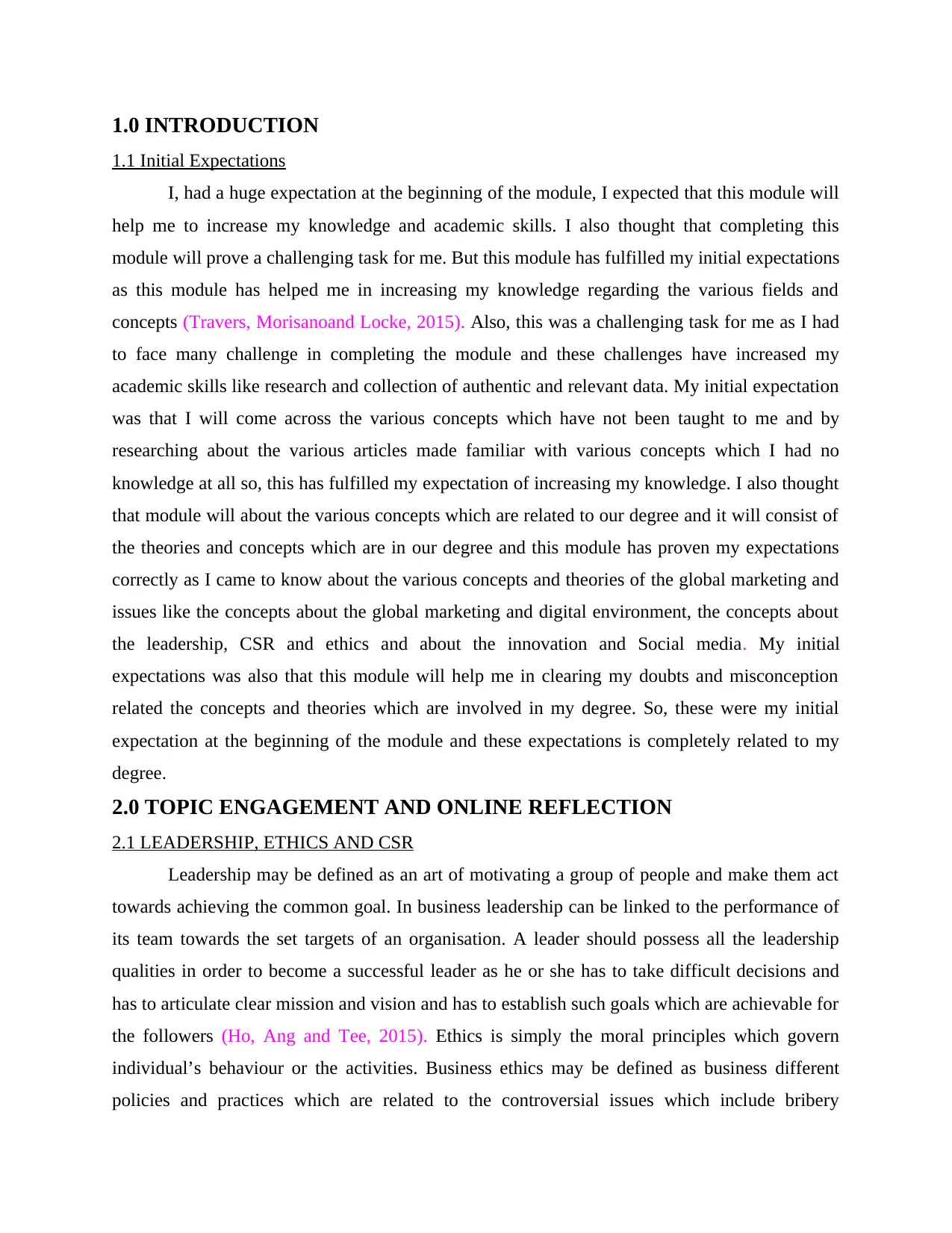
1.0 INTRODUCTION
1.1 Initial Expectations
I, had a huge expectation at the beginning of the module, I expected that this module will
help me to increase my knowledge and academic skills. I also thought that completing this
module will prove a challenging task for me. But this module has fulfilled my initial expectations
as this module has helped me in increasing my knowledge regarding the various fields and
concepts (Travers, Morisanoand Locke, 2015). Also, this was a challenging task for me as I had
to face many challenge in completing the module and these challenges have increased my
academic skills like research and collection of authentic and relevant data. My initial expectation
was that I will come across the various concepts which have not been taught to me and by
researching about the various articles made familiar with various concepts which I had no
knowledge at all so, this has fulfilled my expectation of increasing my knowledge. I also thought
that module will about the various concepts which are related to our degree and it will consist of
the theories and concepts which are in our degree and this module has proven my expectations
correctly as I came to know about the various concepts and theories of the global marketing and
issues like the concepts about the global marketing and digital environment, the concepts about
the leadership, CSR and ethics and about the innovation and Social media. My initial
expectations was also that this module will help me in clearing my doubts and misconception
related the concepts and theories which are involved in my degree. So, these were my initial
expectation at the beginning of the module and these expectations is completely related to my
degree.
2.0 TOPIC ENGAGEMENT AND ONLINE REFLECTION
2.1 LEADERSHIP, ETHICS AND CSR
Leadership may be defined as an art of motivating a group of people and make them act
towards achieving the common goal. In business leadership can be linked to the performance of
its team towards the set targets of an organisation. A leader should possess all the leadership
qualities in order to become a successful leader as he or she has to take difficult decisions and
has to articulate clear mission and vision and has to establish such goals which are achievable for
the followers (Ho, Ang and Tee, 2015). Ethics is simply the moral principles which govern
individual’s behaviour or the activities. Business ethics may be defined as business different
policies and practices which are related to the controversial issues which include bribery
1.1 Initial Expectations
I, had a huge expectation at the beginning of the module, I expected that this module will
help me to increase my knowledge and academic skills. I also thought that completing this
module will prove a challenging task for me. But this module has fulfilled my initial expectations
as this module has helped me in increasing my knowledge regarding the various fields and
concepts (Travers, Morisanoand Locke, 2015). Also, this was a challenging task for me as I had
to face many challenge in completing the module and these challenges have increased my
academic skills like research and collection of authentic and relevant data. My initial expectation
was that I will come across the various concepts which have not been taught to me and by
researching about the various articles made familiar with various concepts which I had no
knowledge at all so, this has fulfilled my expectation of increasing my knowledge. I also thought
that module will about the various concepts which are related to our degree and it will consist of
the theories and concepts which are in our degree and this module has proven my expectations
correctly as I came to know about the various concepts and theories of the global marketing and
issues like the concepts about the global marketing and digital environment, the concepts about
the leadership, CSR and ethics and about the innovation and Social media. My initial
expectations was also that this module will help me in clearing my doubts and misconception
related the concepts and theories which are involved in my degree. So, these were my initial
expectation at the beginning of the module and these expectations is completely related to my
degree.
2.0 TOPIC ENGAGEMENT AND ONLINE REFLECTION
2.1 LEADERSHIP, ETHICS AND CSR
Leadership may be defined as an art of motivating a group of people and make them act
towards achieving the common goal. In business leadership can be linked to the performance of
its team towards the set targets of an organisation. A leader should possess all the leadership
qualities in order to become a successful leader as he or she has to take difficult decisions and
has to articulate clear mission and vision and has to establish such goals which are achievable for
the followers (Ho, Ang and Tee, 2015). Ethics is simply the moral principles which govern
individual’s behaviour or the activities. Business ethics may be defined as business different
policies and practices which are related to the controversial issues which include bribery
⊘ This is a preview!⊘
Do you want full access?
Subscribe today to unlock all pages.

Trusted by 1+ million students worldwide
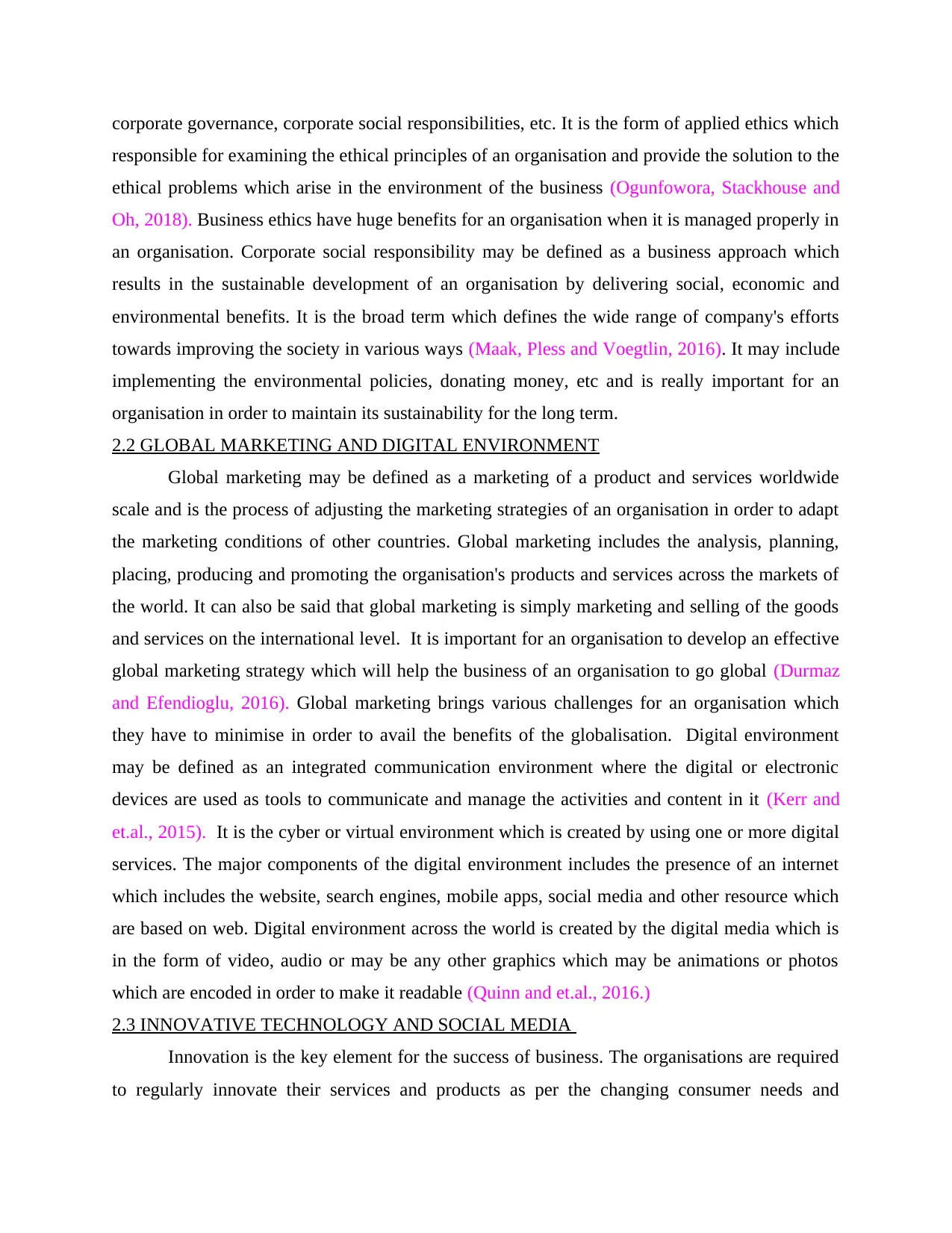
corporate governance, corporate social responsibilities, etc. It is the form of applied ethics which
responsible for examining the ethical principles of an organisation and provide the solution to the
ethical problems which arise in the environment of the business (Ogunfowora, Stackhouse and
Oh, 2018). Business ethics have huge benefits for an organisation when it is managed properly in
an organisation. Corporate social responsibility may be defined as a business approach which
results in the sustainable development of an organisation by delivering social, economic and
environmental benefits. It is the broad term which defines the wide range of company's efforts
towards improving the society in various ways (Maak, Pless and Voegtlin, 2016). It may include
implementing the environmental policies, donating money, etc and is really important for an
organisation in order to maintain its sustainability for the long term.
2.2 GLOBAL MARKETING AND DIGITAL ENVIRONMENT
Global marketing may be defined as a marketing of a product and services worldwide
scale and is the process of adjusting the marketing strategies of an organisation in order to adapt
the marketing conditions of other countries. Global marketing includes the analysis, planning,
placing, producing and promoting the organisation's products and services across the markets of
the world. It can also be said that global marketing is simply marketing and selling of the goods
and services on the international level. It is important for an organisation to develop an effective
global marketing strategy which will help the business of an organisation to go global (Durmaz
and Efendioglu, 2016). Global marketing brings various challenges for an organisation which
they have to minimise in order to avail the benefits of the globalisation. Digital environment
may be defined as an integrated communication environment where the digital or electronic
devices are used as tools to communicate and manage the activities and content in it (Kerr and
et.al., 2015). It is the cyber or virtual environment which is created by using one or more digital
services. The major components of the digital environment includes the presence of an internet
which includes the website, search engines, mobile apps, social media and other resource which
are based on web. Digital environment across the world is created by the digital media which is
in the form of video, audio or may be any other graphics which may be animations or photos
which are encoded in order to make it readable (Quinn and et.al., 2016.)
2.3 INNOVATIVE TECHNOLOGY AND SOCIAL MEDIA
Innovation is the key element for the success of business. The organisations are required
to regularly innovate their services and products as per the changing consumer needs and
responsible for examining the ethical principles of an organisation and provide the solution to the
ethical problems which arise in the environment of the business (Ogunfowora, Stackhouse and
Oh, 2018). Business ethics have huge benefits for an organisation when it is managed properly in
an organisation. Corporate social responsibility may be defined as a business approach which
results in the sustainable development of an organisation by delivering social, economic and
environmental benefits. It is the broad term which defines the wide range of company's efforts
towards improving the society in various ways (Maak, Pless and Voegtlin, 2016). It may include
implementing the environmental policies, donating money, etc and is really important for an
organisation in order to maintain its sustainability for the long term.
2.2 GLOBAL MARKETING AND DIGITAL ENVIRONMENT
Global marketing may be defined as a marketing of a product and services worldwide
scale and is the process of adjusting the marketing strategies of an organisation in order to adapt
the marketing conditions of other countries. Global marketing includes the analysis, planning,
placing, producing and promoting the organisation's products and services across the markets of
the world. It can also be said that global marketing is simply marketing and selling of the goods
and services on the international level. It is important for an organisation to develop an effective
global marketing strategy which will help the business of an organisation to go global (Durmaz
and Efendioglu, 2016). Global marketing brings various challenges for an organisation which
they have to minimise in order to avail the benefits of the globalisation. Digital environment
may be defined as an integrated communication environment where the digital or electronic
devices are used as tools to communicate and manage the activities and content in it (Kerr and
et.al., 2015). It is the cyber or virtual environment which is created by using one or more digital
services. The major components of the digital environment includes the presence of an internet
which includes the website, search engines, mobile apps, social media and other resource which
are based on web. Digital environment across the world is created by the digital media which is
in the form of video, audio or may be any other graphics which may be animations or photos
which are encoded in order to make it readable (Quinn and et.al., 2016.)
2.3 INNOVATIVE TECHNOLOGY AND SOCIAL MEDIA
Innovation is the key element for the success of business. The organisations are required
to regularly innovate their services and products as per the changing consumer needs and
Paraphrase This Document
Need a fresh take? Get an instant paraphrase of this document with our AI Paraphraser
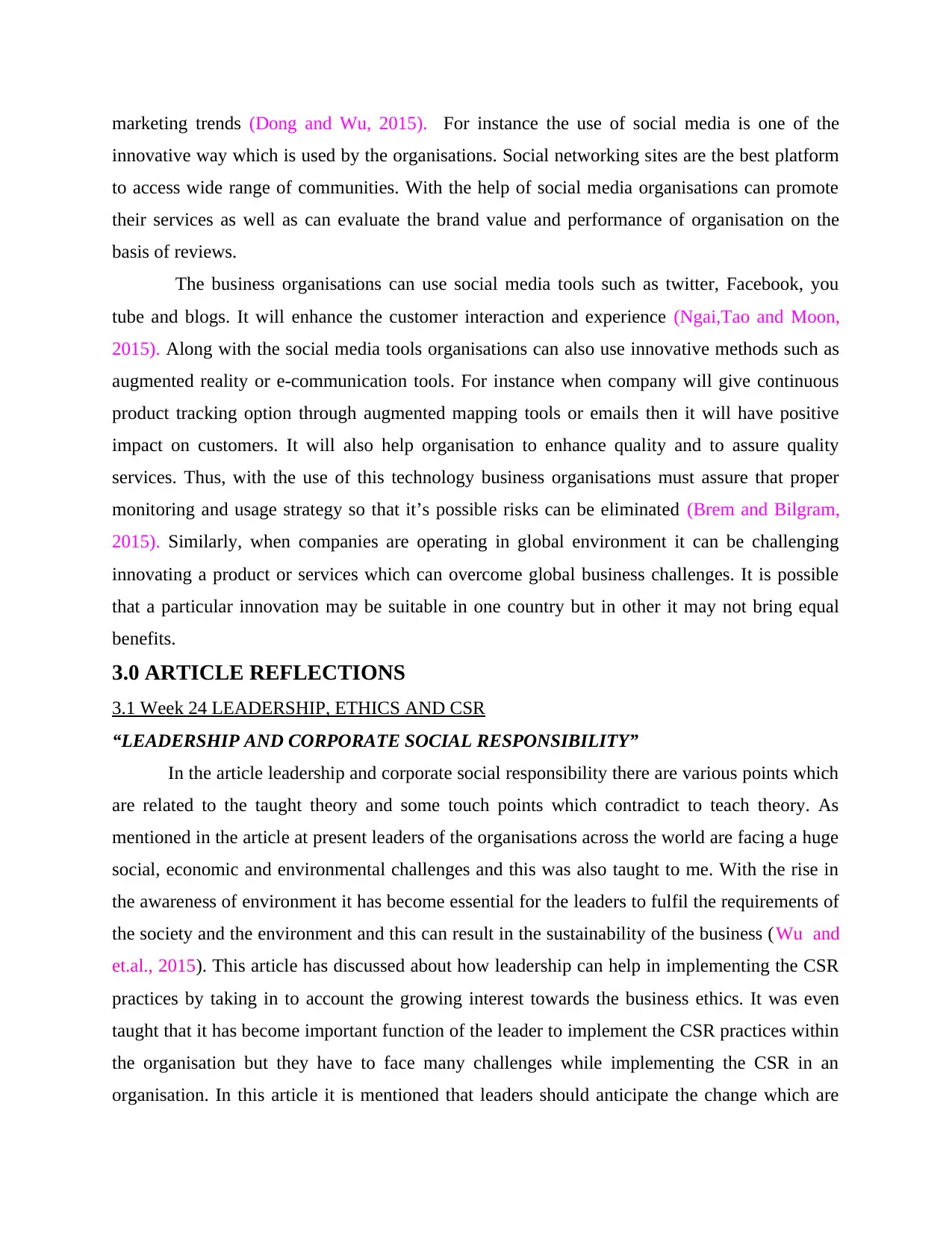
marketing trends (Dong and Wu, 2015). For instance the use of social media is one of the
innovative way which is used by the organisations. Social networking sites are the best platform
to access wide range of communities. With the help of social media organisations can promote
their services as well as can evaluate the brand value and performance of organisation on the
basis of reviews.
The business organisations can use social media tools such as twitter, Facebook, you
tube and blogs. It will enhance the customer interaction and experience (Ngai,Tao and Moon,
2015). Along with the social media tools organisations can also use innovative methods such as
augmented reality or e-communication tools. For instance when company will give continuous
product tracking option through augmented mapping tools or emails then it will have positive
impact on customers. It will also help organisation to enhance quality and to assure quality
services. Thus, with the use of this technology business organisations must assure that proper
monitoring and usage strategy so that it’s possible risks can be eliminated (Brem and Bilgram,
2015). Similarly, when companies are operating in global environment it can be challenging
innovating a product or services which can overcome global business challenges. It is possible
that a particular innovation may be suitable in one country but in other it may not bring equal
benefits.
3.0 ARTICLE REFLECTIONS
3.1 Week 24 LEADERSHIP, ETHICS AND CSR
“LEADERSHIP AND CORPORATE SOCIAL RESPONSIBILITY”
In the article leadership and corporate social responsibility there are various points which
are related to the taught theory and some touch points which contradict to teach theory. As
mentioned in the article at present leaders of the organisations across the world are facing a huge
social, economic and environmental challenges and this was also taught to me. With the rise in
the awareness of environment it has become essential for the leaders to fulfil the requirements of
the society and the environment and this can result in the sustainability of the business ( Wu and
et.al., 2015). This article has discussed about how leadership can help in implementing the CSR
practices by taking in to account the growing interest towards the business ethics. It was even
taught that it has become important function of the leader to implement the CSR practices within
the organisation but they have to face many challenges while implementing the CSR in an
organisation. In this article it is mentioned that leaders should anticipate the change which are
innovative way which is used by the organisations. Social networking sites are the best platform
to access wide range of communities. With the help of social media organisations can promote
their services as well as can evaluate the brand value and performance of organisation on the
basis of reviews.
The business organisations can use social media tools such as twitter, Facebook, you
tube and blogs. It will enhance the customer interaction and experience (Ngai,Tao and Moon,
2015). Along with the social media tools organisations can also use innovative methods such as
augmented reality or e-communication tools. For instance when company will give continuous
product tracking option through augmented mapping tools or emails then it will have positive
impact on customers. It will also help organisation to enhance quality and to assure quality
services. Thus, with the use of this technology business organisations must assure that proper
monitoring and usage strategy so that it’s possible risks can be eliminated (Brem and Bilgram,
2015). Similarly, when companies are operating in global environment it can be challenging
innovating a product or services which can overcome global business challenges. It is possible
that a particular innovation may be suitable in one country but in other it may not bring equal
benefits.
3.0 ARTICLE REFLECTIONS
3.1 Week 24 LEADERSHIP, ETHICS AND CSR
“LEADERSHIP AND CORPORATE SOCIAL RESPONSIBILITY”
In the article leadership and corporate social responsibility there are various points which
are related to the taught theory and some touch points which contradict to teach theory. As
mentioned in the article at present leaders of the organisations across the world are facing a huge
social, economic and environmental challenges and this was also taught to me. With the rise in
the awareness of environment it has become essential for the leaders to fulfil the requirements of
the society and the environment and this can result in the sustainability of the business ( Wu and
et.al., 2015). This article has discussed about how leadership can help in implementing the CSR
practices by taking in to account the growing interest towards the business ethics. It was even
taught that it has become important function of the leader to implement the CSR practices within
the organisation but they have to face many challenges while implementing the CSR in an
organisation. In this article it is mentioned that leaders should anticipate the change which are
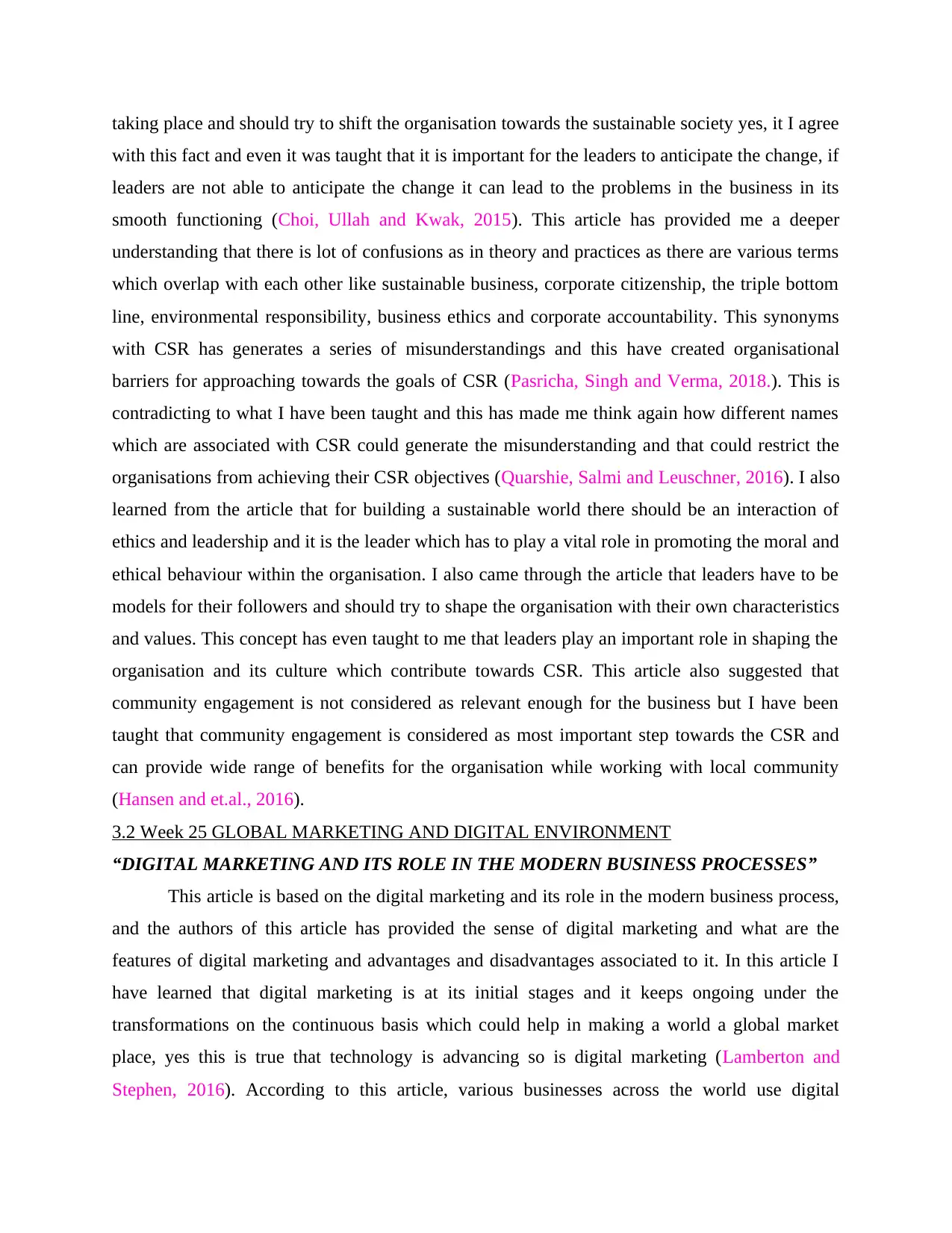
taking place and should try to shift the organisation towards the sustainable society yes, it I agree
with this fact and even it was taught that it is important for the leaders to anticipate the change, if
leaders are not able to anticipate the change it can lead to the problems in the business in its
smooth functioning (Choi, Ullah and Kwak, 2015). This article has provided me a deeper
understanding that there is lot of confusions as in theory and practices as there are various terms
which overlap with each other like sustainable business, corporate citizenship, the triple bottom
line, environmental responsibility, business ethics and corporate accountability. This synonyms
with CSR has generates a series of misunderstandings and this have created organisational
barriers for approaching towards the goals of CSR (Pasricha, Singh and Verma, 2018.). This is
contradicting to what I have been taught and this has made me think again how different names
which are associated with CSR could generate the misunderstanding and that could restrict the
organisations from achieving their CSR objectives (Quarshie, Salmi and Leuschner, 2016). I also
learned from the article that for building a sustainable world there should be an interaction of
ethics and leadership and it is the leader which has to play a vital role in promoting the moral and
ethical behaviour within the organisation. I also came through the article that leaders have to be
models for their followers and should try to shape the organisation with their own characteristics
and values. This concept has even taught to me that leaders play an important role in shaping the
organisation and its culture which contribute towards CSR. This article also suggested that
community engagement is not considered as relevant enough for the business but I have been
taught that community engagement is considered as most important step towards the CSR and
can provide wide range of benefits for the organisation while working with local community
(Hansen and et.al., 2016).
3.2 Week 25 GLOBAL MARKETING AND DIGITAL ENVIRONMENT
“DIGITAL MARKETING AND ITS ROLE IN THE MODERN BUSINESS PROCESSES”
This article is based on the digital marketing and its role in the modern business process,
and the authors of this article has provided the sense of digital marketing and what are the
features of digital marketing and advantages and disadvantages associated to it. In this article I
have learned that digital marketing is at its initial stages and it keeps ongoing under the
transformations on the continuous basis which could help in making a world a global market
place, yes this is true that technology is advancing so is digital marketing (Lamberton and
Stephen, 2016). According to this article, various businesses across the world use digital
with this fact and even it was taught that it is important for the leaders to anticipate the change, if
leaders are not able to anticipate the change it can lead to the problems in the business in its
smooth functioning (Choi, Ullah and Kwak, 2015). This article has provided me a deeper
understanding that there is lot of confusions as in theory and practices as there are various terms
which overlap with each other like sustainable business, corporate citizenship, the triple bottom
line, environmental responsibility, business ethics and corporate accountability. This synonyms
with CSR has generates a series of misunderstandings and this have created organisational
barriers for approaching towards the goals of CSR (Pasricha, Singh and Verma, 2018.). This is
contradicting to what I have been taught and this has made me think again how different names
which are associated with CSR could generate the misunderstanding and that could restrict the
organisations from achieving their CSR objectives (Quarshie, Salmi and Leuschner, 2016). I also
learned from the article that for building a sustainable world there should be an interaction of
ethics and leadership and it is the leader which has to play a vital role in promoting the moral and
ethical behaviour within the organisation. I also came through the article that leaders have to be
models for their followers and should try to shape the organisation with their own characteristics
and values. This concept has even taught to me that leaders play an important role in shaping the
organisation and its culture which contribute towards CSR. This article also suggested that
community engagement is not considered as relevant enough for the business but I have been
taught that community engagement is considered as most important step towards the CSR and
can provide wide range of benefits for the organisation while working with local community
(Hansen and et.al., 2016).
3.2 Week 25 GLOBAL MARKETING AND DIGITAL ENVIRONMENT
“DIGITAL MARKETING AND ITS ROLE IN THE MODERN BUSINESS PROCESSES”
This article is based on the digital marketing and its role in the modern business process,
and the authors of this article has provided the sense of digital marketing and what are the
features of digital marketing and advantages and disadvantages associated to it. In this article I
have learned that digital marketing is at its initial stages and it keeps ongoing under the
transformations on the continuous basis which could help in making a world a global market
place, yes this is true that technology is advancing so is digital marketing (Lamberton and
Stephen, 2016). According to this article, various businesses across the world use digital
⊘ This is a preview!⊘
Do you want full access?
Subscribe today to unlock all pages.

Trusted by 1+ million students worldwide
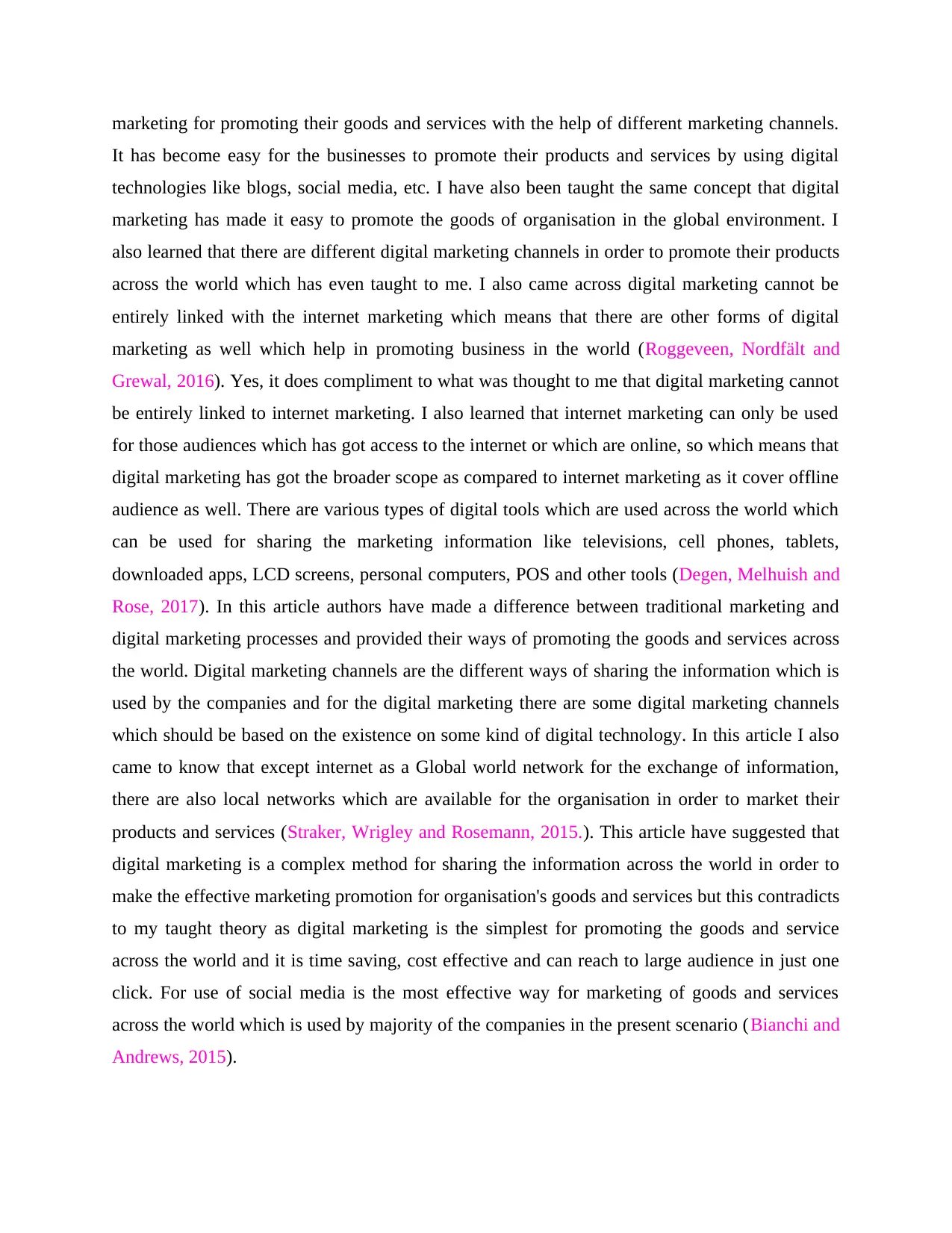
marketing for promoting their goods and services with the help of different marketing channels.
It has become easy for the businesses to promote their products and services by using digital
technologies like blogs, social media, etc. I have also been taught the same concept that digital
marketing has made it easy to promote the goods of organisation in the global environment. I
also learned that there are different digital marketing channels in order to promote their products
across the world which has even taught to me. I also came across digital marketing cannot be
entirely linked with the internet marketing which means that there are other forms of digital
marketing as well which help in promoting business in the world (Roggeveen, Nordfält and
Grewal, 2016). Yes, it does compliment to what was thought to me that digital marketing cannot
be entirely linked to internet marketing. I also learned that internet marketing can only be used
for those audiences which has got access to the internet or which are online, so which means that
digital marketing has got the broader scope as compared to internet marketing as it cover offline
audience as well. There are various types of digital tools which are used across the world which
can be used for sharing the marketing information like televisions, cell phones, tablets,
downloaded apps, LCD screens, personal computers, POS and other tools (Degen, Melhuish and
Rose, 2017). In this article authors have made a difference between traditional marketing and
digital marketing processes and provided their ways of promoting the goods and services across
the world. Digital marketing channels are the different ways of sharing the information which is
used by the companies and for the digital marketing there are some digital marketing channels
which should be based on the existence on some kind of digital technology. In this article I also
came to know that except internet as a Global world network for the exchange of information,
there are also local networks which are available for the organisation in order to market their
products and services (Straker, Wrigley and Rosemann, 2015.). This article have suggested that
digital marketing is a complex method for sharing the information across the world in order to
make the effective marketing promotion for organisation's goods and services but this contradicts
to my taught theory as digital marketing is the simplest for promoting the goods and service
across the world and it is time saving, cost effective and can reach to large audience in just one
click. For use of social media is the most effective way for marketing of goods and services
across the world which is used by majority of the companies in the present scenario (Bianchi and
Andrews, 2015).
It has become easy for the businesses to promote their products and services by using digital
technologies like blogs, social media, etc. I have also been taught the same concept that digital
marketing has made it easy to promote the goods of organisation in the global environment. I
also learned that there are different digital marketing channels in order to promote their products
across the world which has even taught to me. I also came across digital marketing cannot be
entirely linked with the internet marketing which means that there are other forms of digital
marketing as well which help in promoting business in the world (Roggeveen, Nordfält and
Grewal, 2016). Yes, it does compliment to what was thought to me that digital marketing cannot
be entirely linked to internet marketing. I also learned that internet marketing can only be used
for those audiences which has got access to the internet or which are online, so which means that
digital marketing has got the broader scope as compared to internet marketing as it cover offline
audience as well. There are various types of digital tools which are used across the world which
can be used for sharing the marketing information like televisions, cell phones, tablets,
downloaded apps, LCD screens, personal computers, POS and other tools (Degen, Melhuish and
Rose, 2017). In this article authors have made a difference between traditional marketing and
digital marketing processes and provided their ways of promoting the goods and services across
the world. Digital marketing channels are the different ways of sharing the information which is
used by the companies and for the digital marketing there are some digital marketing channels
which should be based on the existence on some kind of digital technology. In this article I also
came to know that except internet as a Global world network for the exchange of information,
there are also local networks which are available for the organisation in order to market their
products and services (Straker, Wrigley and Rosemann, 2015.). This article have suggested that
digital marketing is a complex method for sharing the information across the world in order to
make the effective marketing promotion for organisation's goods and services but this contradicts
to my taught theory as digital marketing is the simplest for promoting the goods and service
across the world and it is time saving, cost effective and can reach to large audience in just one
click. For use of social media is the most effective way for marketing of goods and services
across the world which is used by majority of the companies in the present scenario (Bianchi and
Andrews, 2015).
Paraphrase This Document
Need a fresh take? Get an instant paraphrase of this document with our AI Paraphraser
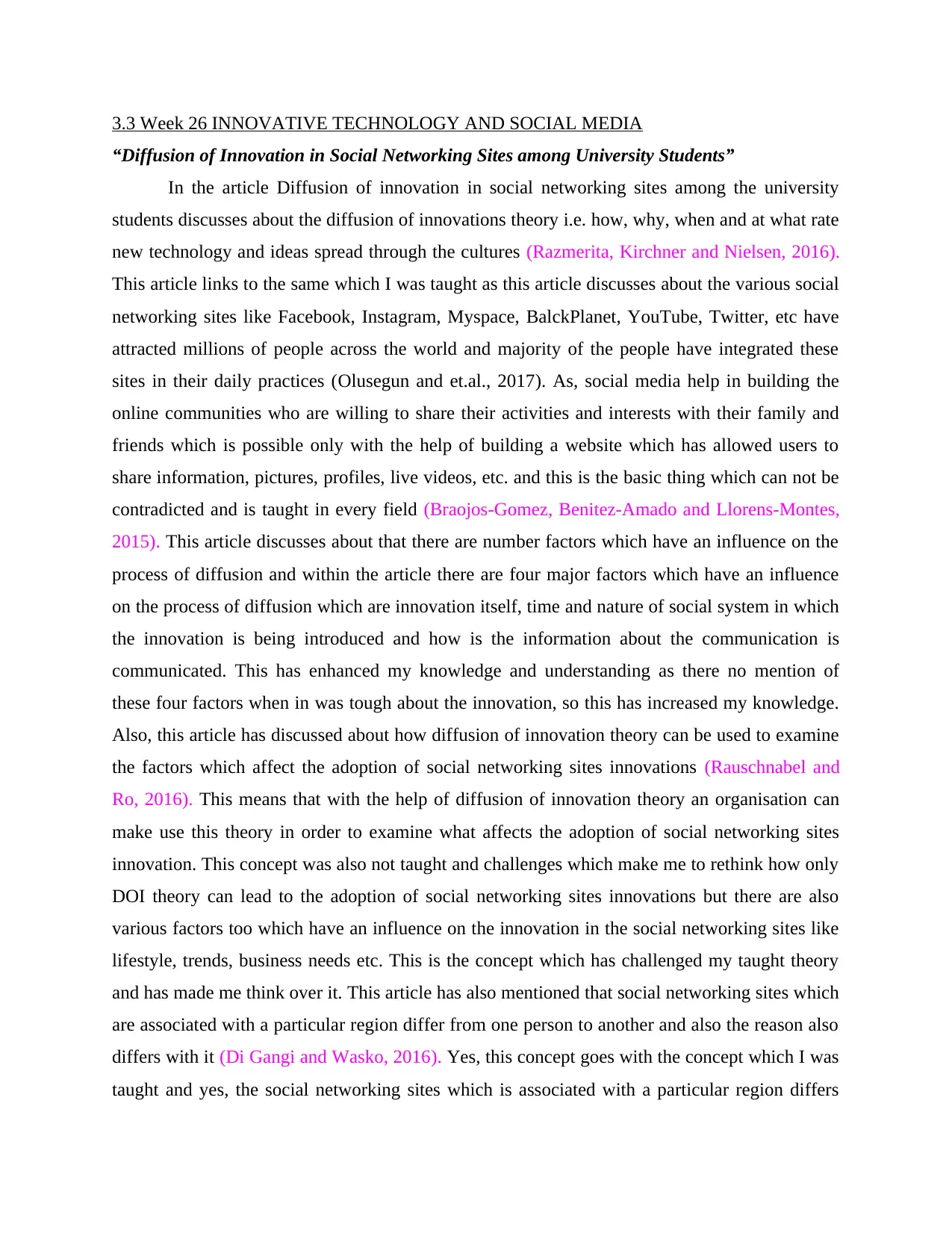
3.3 Week 26 INNOVATIVE TECHNOLOGY AND SOCIAL MEDIA
“Diffusion of Innovation in Social Networking Sites among University Students”
In the article Diffusion of innovation in social networking sites among the university
students discusses about the diffusion of innovations theory i.e. how, why, when and at what rate
new technology and ideas spread through the cultures (Razmerita, Kirchner and Nielsen, 2016).
This article links to the same which I was taught as this article discusses about the various social
networking sites like Facebook, Instagram, Myspace, BalckPlanet, YouTube, Twitter, etc have
attracted millions of people across the world and majority of the people have integrated these
sites in their daily practices (Olusegun and et.al., 2017). As, social media help in building the
online communities who are willing to share their activities and interests with their family and
friends which is possible only with the help of building a website which has allowed users to
share information, pictures, profiles, live videos, etc. and this is the basic thing which can not be
contradicted and is taught in every field (Braojos-Gomez, Benitez-Amado and Llorens-Montes,
2015). This article discusses about that there are number factors which have an influence on the
process of diffusion and within the article there are four major factors which have an influence
on the process of diffusion which are innovation itself, time and nature of social system in which
the innovation is being introduced and how is the information about the communication is
communicated. This has enhanced my knowledge and understanding as there no mention of
these four factors when in was tough about the innovation, so this has increased my knowledge.
Also, this article has discussed about how diffusion of innovation theory can be used to examine
the factors which affect the adoption of social networking sites innovations (Rauschnabel and
Ro, 2016). This means that with the help of diffusion of innovation theory an organisation can
make use this theory in order to examine what affects the adoption of social networking sites
innovation. This concept was also not taught and challenges which make me to rethink how only
DOI theory can lead to the adoption of social networking sites innovations but there are also
various factors too which have an influence on the innovation in the social networking sites like
lifestyle, trends, business needs etc. This is the concept which has challenged my taught theory
and has made me think over it. This article has also mentioned that social networking sites which
are associated with a particular region differ from one person to another and also the reason also
differs with it (Di Gangi and Wasko, 2016). Yes, this concept goes with the concept which I was
taught and yes, the social networking sites which is associated with a particular region differs
“Diffusion of Innovation in Social Networking Sites among University Students”
In the article Diffusion of innovation in social networking sites among the university
students discusses about the diffusion of innovations theory i.e. how, why, when and at what rate
new technology and ideas spread through the cultures (Razmerita, Kirchner and Nielsen, 2016).
This article links to the same which I was taught as this article discusses about the various social
networking sites like Facebook, Instagram, Myspace, BalckPlanet, YouTube, Twitter, etc have
attracted millions of people across the world and majority of the people have integrated these
sites in their daily practices (Olusegun and et.al., 2017). As, social media help in building the
online communities who are willing to share their activities and interests with their family and
friends which is possible only with the help of building a website which has allowed users to
share information, pictures, profiles, live videos, etc. and this is the basic thing which can not be
contradicted and is taught in every field (Braojos-Gomez, Benitez-Amado and Llorens-Montes,
2015). This article discusses about that there are number factors which have an influence on the
process of diffusion and within the article there are four major factors which have an influence
on the process of diffusion which are innovation itself, time and nature of social system in which
the innovation is being introduced and how is the information about the communication is
communicated. This has enhanced my knowledge and understanding as there no mention of
these four factors when in was tough about the innovation, so this has increased my knowledge.
Also, this article has discussed about how diffusion of innovation theory can be used to examine
the factors which affect the adoption of social networking sites innovations (Rauschnabel and
Ro, 2016). This means that with the help of diffusion of innovation theory an organisation can
make use this theory in order to examine what affects the adoption of social networking sites
innovation. This concept was also not taught and challenges which make me to rethink how only
DOI theory can lead to the adoption of social networking sites innovations but there are also
various factors too which have an influence on the innovation in the social networking sites like
lifestyle, trends, business needs etc. This is the concept which has challenged my taught theory
and has made me think over it. This article has also mentioned that social networking sites which
are associated with a particular region differ from one person to another and also the reason also
differs with it (Di Gangi and Wasko, 2016). Yes, this concept goes with the concept which I was
taught and yes, the social networking sites which is associated with a particular region differs
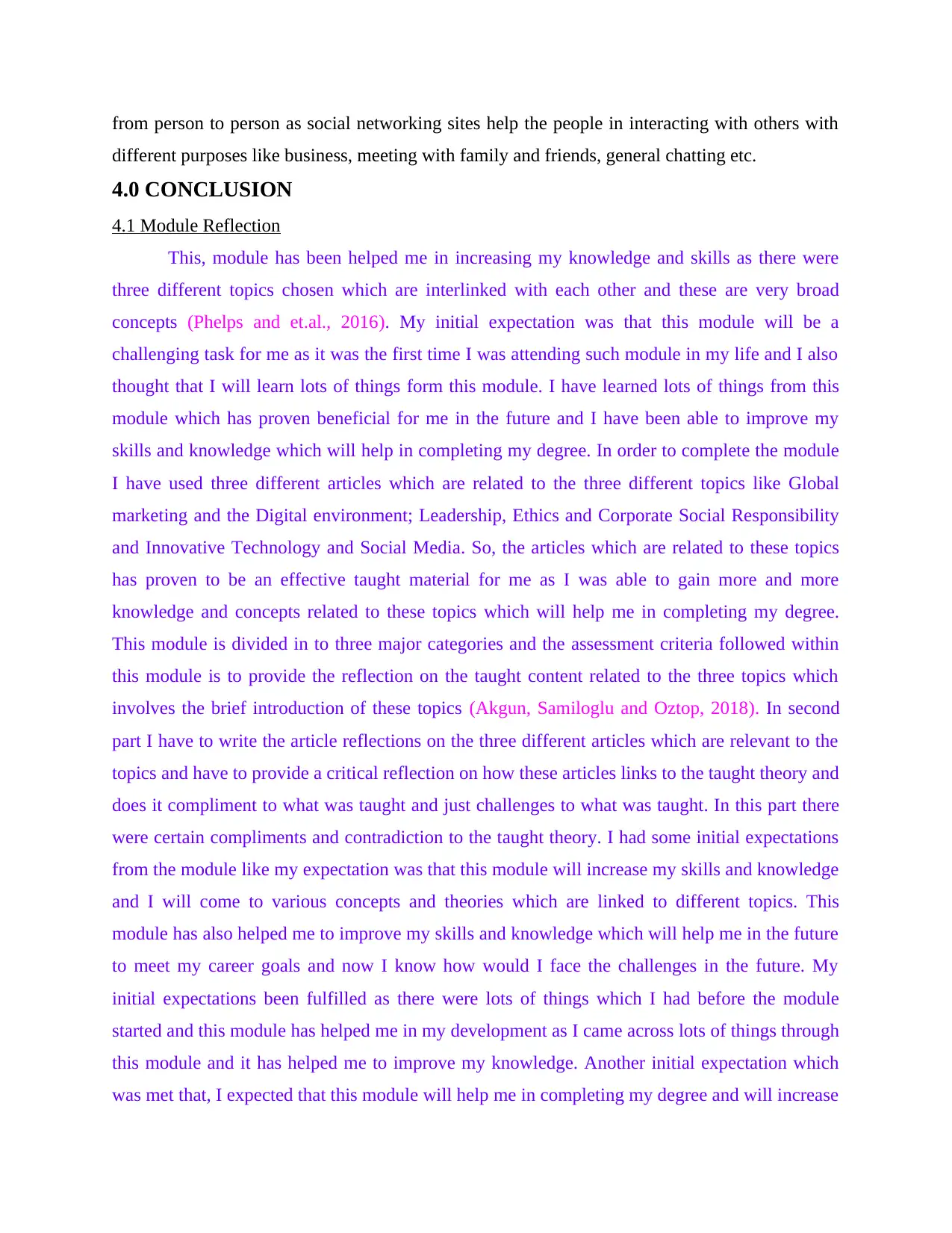
from person to person as social networking sites help the people in interacting with others with
different purposes like business, meeting with family and friends, general chatting etc.
4.0 CONCLUSION
4.1 Module Reflection
This, module has been helped me in increasing my knowledge and skills as there were
three different topics chosen which are interlinked with each other and these are very broad
concepts (Phelps and et.al., 2016). My initial expectation was that this module will be a
challenging task for me as it was the first time I was attending such module in my life and I also
thought that I will learn lots of things form this module. I have learned lots of things from this
module which has proven beneficial for me in the future and I have been able to improve my
skills and knowledge which will help in completing my degree. In order to complete the module
I have used three different articles which are related to the three different topics like Global
marketing and the Digital environment; Leadership, Ethics and Corporate Social Responsibility
and Innovative Technology and Social Media. So, the articles which are related to these topics
has proven to be an effective taught material for me as I was able to gain more and more
knowledge and concepts related to these topics which will help me in completing my degree.
This module is divided in to three major categories and the assessment criteria followed within
this module is to provide the reflection on the taught content related to the three topics which
involves the brief introduction of these topics (Akgun, Samiloglu and Oztop, 2018). In second
part I have to write the article reflections on the three different articles which are relevant to the
topics and have to provide a critical reflection on how these articles links to the taught theory and
does it compliment to what was taught and just challenges to what was taught. In this part there
were certain compliments and contradiction to the taught theory. I had some initial expectations
from the module like my expectation was that this module will increase my skills and knowledge
and I will come to various concepts and theories which are linked to different topics. This
module has also helped me to improve my skills and knowledge which will help me in the future
to meet my career goals and now I know how would I face the challenges in the future. My
initial expectations been fulfilled as there were lots of things which I had before the module
started and this module has helped me in my development as I came across lots of things through
this module and it has helped me to improve my knowledge. Another initial expectation which
was met that, I expected that this module will help me in completing my degree and will increase
different purposes like business, meeting with family and friends, general chatting etc.
4.0 CONCLUSION
4.1 Module Reflection
This, module has been helped me in increasing my knowledge and skills as there were
three different topics chosen which are interlinked with each other and these are very broad
concepts (Phelps and et.al., 2016). My initial expectation was that this module will be a
challenging task for me as it was the first time I was attending such module in my life and I also
thought that I will learn lots of things form this module. I have learned lots of things from this
module which has proven beneficial for me in the future and I have been able to improve my
skills and knowledge which will help in completing my degree. In order to complete the module
I have used three different articles which are related to the three different topics like Global
marketing and the Digital environment; Leadership, Ethics and Corporate Social Responsibility
and Innovative Technology and Social Media. So, the articles which are related to these topics
has proven to be an effective taught material for me as I was able to gain more and more
knowledge and concepts related to these topics which will help me in completing my degree.
This module is divided in to three major categories and the assessment criteria followed within
this module is to provide the reflection on the taught content related to the three topics which
involves the brief introduction of these topics (Akgun, Samiloglu and Oztop, 2018). In second
part I have to write the article reflections on the three different articles which are relevant to the
topics and have to provide a critical reflection on how these articles links to the taught theory and
does it compliment to what was taught and just challenges to what was taught. In this part there
were certain compliments and contradiction to the taught theory. I had some initial expectations
from the module like my expectation was that this module will increase my skills and knowledge
and I will come to various concepts and theories which are linked to different topics. This
module has also helped me to improve my skills and knowledge which will help me in the future
to meet my career goals and now I know how would I face the challenges in the future. My
initial expectations been fulfilled as there were lots of things which I had before the module
started and this module has helped me in my development as I came across lots of things through
this module and it has helped me to improve my knowledge. Another initial expectation which
was met that, I expected that this module will help me in completing my degree and will increase
⊘ This is a preview!⊘
Do you want full access?
Subscribe today to unlock all pages.

Trusted by 1+ million students worldwide

my academic knowledge which will make pursuing my degree easily and I will be able to score
high in my exams or tests which will be conducted in the class. This initial expectation was also
fulfilled, and I am fortunate that I have attended this module. So, these were my expectations
which I had at the beginning of the module and almost all of my expectations were fulfilled from
beginning till end of this module.
high in my exams or tests which will be conducted in the class. This initial expectation was also
fulfilled, and I am fortunate that I have attended this module. So, these were my expectations
which I had at the beginning of the module and almost all of my expectations were fulfilled from
beginning till end of this module.
Paraphrase This Document
Need a fresh take? Get an instant paraphrase of this document with our AI Paraphraser
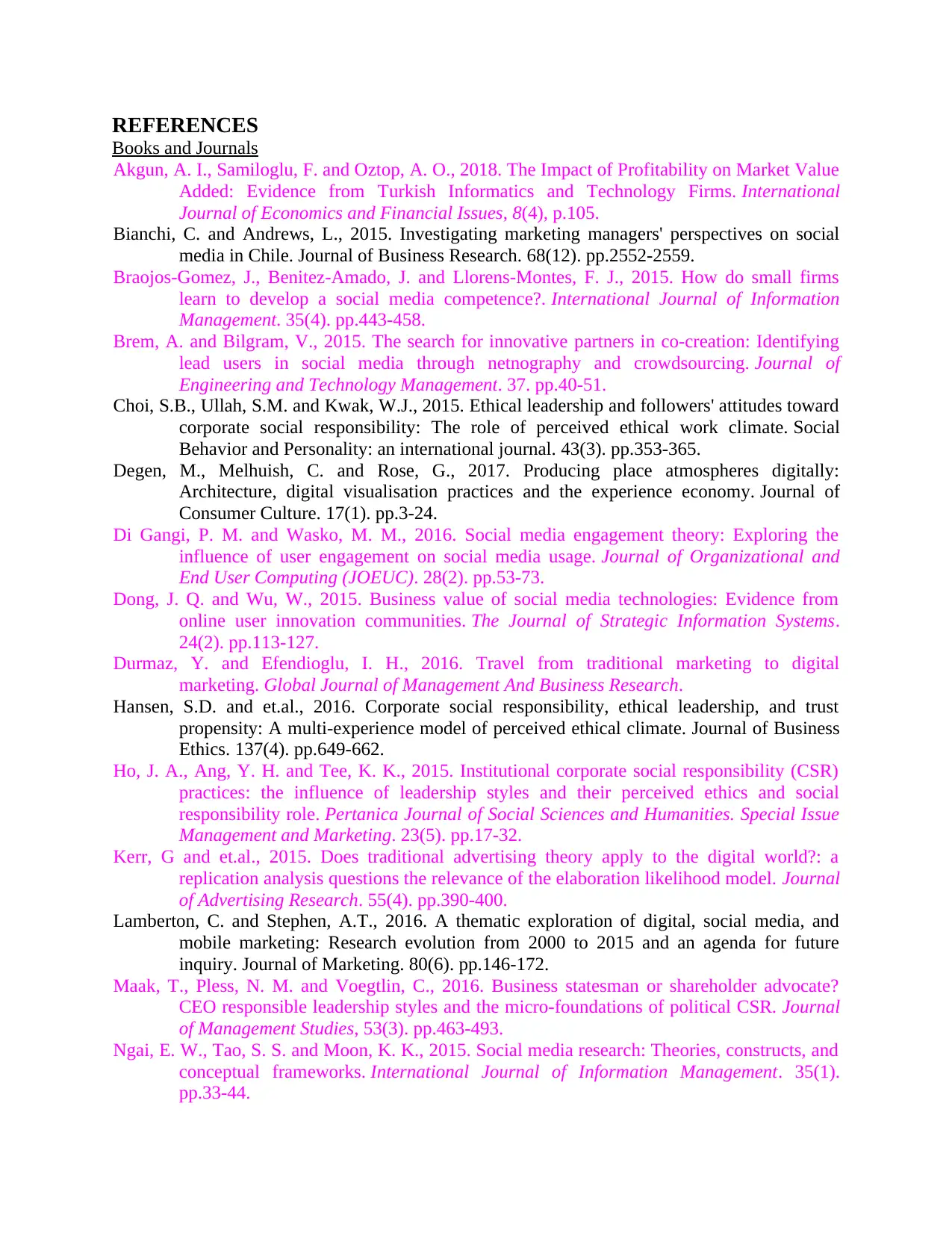
REFERENCES
Books and Journals
Akgun, A. I., Samiloglu, F. and Oztop, A. O., 2018. The Impact of Profitability on Market Value
Added: Evidence from Turkish Informatics and Technology Firms. International
Journal of Economics and Financial Issues, 8(4), p.105.
Bianchi, C. and Andrews, L., 2015. Investigating marketing managers' perspectives on social
media in Chile. Journal of Business Research. 68(12). pp.2552-2559.
Braojos-Gomez, J., Benitez-Amado, J. and Llorens-Montes, F. J., 2015. How do small firms
learn to develop a social media competence?. International Journal of Information
Management. 35(4). pp.443-458.
Brem, A. and Bilgram, V., 2015. The search for innovative partners in co-creation: Identifying
lead users in social media through netnography and crowdsourcing. Journal of
Engineering and Technology Management. 37. pp.40-51.
Choi, S.B., Ullah, S.M. and Kwak, W.J., 2015. Ethical leadership and followers' attitudes toward
corporate social responsibility: The role of perceived ethical work climate. Social
Behavior and Personality: an international journal. 43(3). pp.353-365.
Degen, M., Melhuish, C. and Rose, G., 2017. Producing place atmospheres digitally:
Architecture, digital visualisation practices and the experience economy. Journal of
Consumer Culture. 17(1). pp.3-24.
Di Gangi, P. M. and Wasko, M. M., 2016. Social media engagement theory: Exploring the
influence of user engagement on social media usage. Journal of Organizational and
End User Computing (JOEUC). 28(2). pp.53-73.
Dong, J. Q. and Wu, W., 2015. Business value of social media technologies: Evidence from
online user innovation communities. The Journal of Strategic Information Systems.
24(2). pp.113-127.
Durmaz, Y. and Efendioglu, I. H., 2016. Travel from traditional marketing to digital
marketing. Global Journal of Management And Business Research.
Hansen, S.D. and et.al., 2016. Corporate social responsibility, ethical leadership, and trust
propensity: A multi-experience model of perceived ethical climate. Journal of Business
Ethics. 137(4). pp.649-662.
Ho, J. A., Ang, Y. H. and Tee, K. K., 2015. Institutional corporate social responsibility (CSR)
practices: the influence of leadership styles and their perceived ethics and social
responsibility role. Pertanica Journal of Social Sciences and Humanities. Special Issue
Management and Marketing. 23(5). pp.17-32.
Kerr, G and et.al., 2015. Does traditional advertising theory apply to the digital world?: a
replication analysis questions the relevance of the elaboration likelihood model. Journal
of Advertising Research. 55(4). pp.390-400.
Lamberton, C. and Stephen, A.T., 2016. A thematic exploration of digital, social media, and
mobile marketing: Research evolution from 2000 to 2015 and an agenda for future
inquiry. Journal of Marketing. 80(6). pp.146-172.
Maak, T., Pless, N. M. and Voegtlin, C., 2016. Business statesman or shareholder advocate?
CEO responsible leadership styles and the micro‐foundations of political CSR. Journal
of Management Studies, 53(3). pp.463-493.
Ngai, E. W., Tao, S. S. and Moon, K. K., 2015. Social media research: Theories, constructs, and
conceptual frameworks. International Journal of Information Management. 35(1).
pp.33-44.
Books and Journals
Akgun, A. I., Samiloglu, F. and Oztop, A. O., 2018. The Impact of Profitability on Market Value
Added: Evidence from Turkish Informatics and Technology Firms. International
Journal of Economics and Financial Issues, 8(4), p.105.
Bianchi, C. and Andrews, L., 2015. Investigating marketing managers' perspectives on social
media in Chile. Journal of Business Research. 68(12). pp.2552-2559.
Braojos-Gomez, J., Benitez-Amado, J. and Llorens-Montes, F. J., 2015. How do small firms
learn to develop a social media competence?. International Journal of Information
Management. 35(4). pp.443-458.
Brem, A. and Bilgram, V., 2015. The search for innovative partners in co-creation: Identifying
lead users in social media through netnography and crowdsourcing. Journal of
Engineering and Technology Management. 37. pp.40-51.
Choi, S.B., Ullah, S.M. and Kwak, W.J., 2015. Ethical leadership and followers' attitudes toward
corporate social responsibility: The role of perceived ethical work climate. Social
Behavior and Personality: an international journal. 43(3). pp.353-365.
Degen, M., Melhuish, C. and Rose, G., 2017. Producing place atmospheres digitally:
Architecture, digital visualisation practices and the experience economy. Journal of
Consumer Culture. 17(1). pp.3-24.
Di Gangi, P. M. and Wasko, M. M., 2016. Social media engagement theory: Exploring the
influence of user engagement on social media usage. Journal of Organizational and
End User Computing (JOEUC). 28(2). pp.53-73.
Dong, J. Q. and Wu, W., 2015. Business value of social media technologies: Evidence from
online user innovation communities. The Journal of Strategic Information Systems.
24(2). pp.113-127.
Durmaz, Y. and Efendioglu, I. H., 2016. Travel from traditional marketing to digital
marketing. Global Journal of Management And Business Research.
Hansen, S.D. and et.al., 2016. Corporate social responsibility, ethical leadership, and trust
propensity: A multi-experience model of perceived ethical climate. Journal of Business
Ethics. 137(4). pp.649-662.
Ho, J. A., Ang, Y. H. and Tee, K. K., 2015. Institutional corporate social responsibility (CSR)
practices: the influence of leadership styles and their perceived ethics and social
responsibility role. Pertanica Journal of Social Sciences and Humanities. Special Issue
Management and Marketing. 23(5). pp.17-32.
Kerr, G and et.al., 2015. Does traditional advertising theory apply to the digital world?: a
replication analysis questions the relevance of the elaboration likelihood model. Journal
of Advertising Research. 55(4). pp.390-400.
Lamberton, C. and Stephen, A.T., 2016. A thematic exploration of digital, social media, and
mobile marketing: Research evolution from 2000 to 2015 and an agenda for future
inquiry. Journal of Marketing. 80(6). pp.146-172.
Maak, T., Pless, N. M. and Voegtlin, C., 2016. Business statesman or shareholder advocate?
CEO responsible leadership styles and the micro‐foundations of political CSR. Journal
of Management Studies, 53(3). pp.463-493.
Ngai, E. W., Tao, S. S. and Moon, K. K., 2015. Social media research: Theories, constructs, and
conceptual frameworks. International Journal of Information Management. 35(1).
pp.33-44.
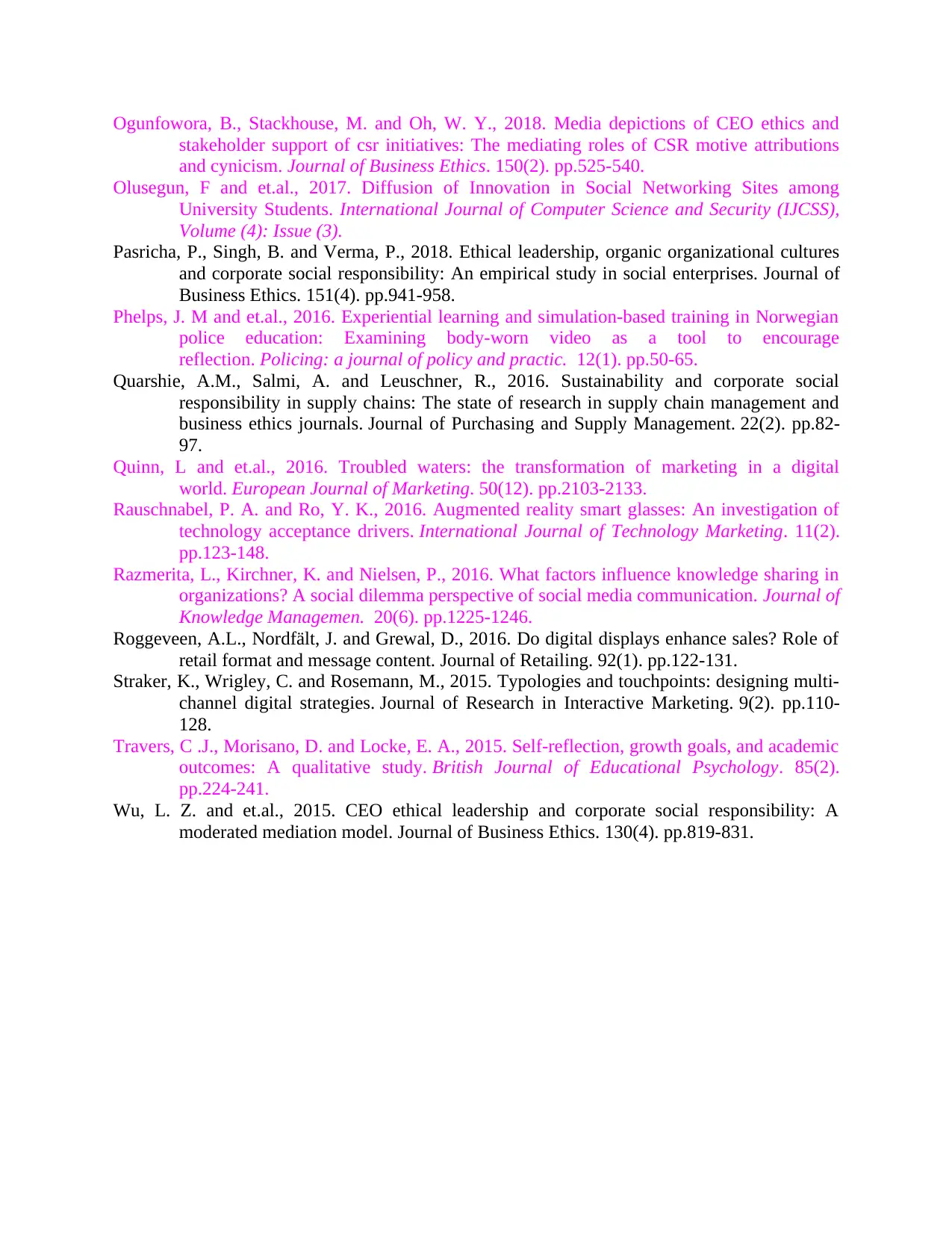
Ogunfowora, B., Stackhouse, M. and Oh, W. Y., 2018. Media depictions of CEO ethics and
stakeholder support of csr initiatives: The mediating roles of CSR motive attributions
and cynicism. Journal of Business Ethics. 150(2). pp.525-540.
Olusegun, F and et.al., 2017. Diffusion of Innovation in Social Networking Sites among
University Students. International Journal of Computer Science and Security (IJCSS),
Volume (4): Issue (3).
Pasricha, P., Singh, B. and Verma, P., 2018. Ethical leadership, organic organizational cultures
and corporate social responsibility: An empirical study in social enterprises. Journal of
Business Ethics. 151(4). pp.941-958.
Phelps, J. M and et.al., 2016. Experiential learning and simulation-based training in Norwegian
police education: Examining body-worn video as a tool to encourage
reflection. Policing: a journal of policy and practic. 12(1). pp.50-65.
Quarshie, A.M., Salmi, A. and Leuschner, R., 2016. Sustainability and corporate social
responsibility in supply chains: The state of research in supply chain management and
business ethics journals. Journal of Purchasing and Supply Management. 22(2). pp.82-
97.
Quinn, L and et.al., 2016. Troubled waters: the transformation of marketing in a digital
world. European Journal of Marketing. 50(12). pp.2103-2133.
Rauschnabel, P. A. and Ro, Y. K., 2016. Augmented reality smart glasses: An investigation of
technology acceptance drivers. International Journal of Technology Marketing. 11(2).
pp.123-148.
Razmerita, L., Kirchner, K. and Nielsen, P., 2016. What factors influence knowledge sharing in
organizations? A social dilemma perspective of social media communication. Journal of
Knowledge Managemen. 20(6). pp.1225-1246.
Roggeveen, A.L., Nordfält, J. and Grewal, D., 2016. Do digital displays enhance sales? Role of
retail format and message content. Journal of Retailing. 92(1). pp.122-131.
Straker, K., Wrigley, C. and Rosemann, M., 2015. Typologies and touchpoints: designing multi-
channel digital strategies. Journal of Research in Interactive Marketing. 9(2). pp.110-
128.
Travers, C .J., Morisano, D. and Locke, E. A., 2015. Self‐reflection, growth goals, and academic
outcomes: A qualitative study. British Journal of Educational Psychology. 85(2).
pp.224-241.
Wu, L. Z. and et.al., 2015. CEO ethical leadership and corporate social responsibility: A
moderated mediation model. Journal of Business Ethics. 130(4). pp.819-831.
stakeholder support of csr initiatives: The mediating roles of CSR motive attributions
and cynicism. Journal of Business Ethics. 150(2). pp.525-540.
Olusegun, F and et.al., 2017. Diffusion of Innovation in Social Networking Sites among
University Students. International Journal of Computer Science and Security (IJCSS),
Volume (4): Issue (3).
Pasricha, P., Singh, B. and Verma, P., 2018. Ethical leadership, organic organizational cultures
and corporate social responsibility: An empirical study in social enterprises. Journal of
Business Ethics. 151(4). pp.941-958.
Phelps, J. M and et.al., 2016. Experiential learning and simulation-based training in Norwegian
police education: Examining body-worn video as a tool to encourage
reflection. Policing: a journal of policy and practic. 12(1). pp.50-65.
Quarshie, A.M., Salmi, A. and Leuschner, R., 2016. Sustainability and corporate social
responsibility in supply chains: The state of research in supply chain management and
business ethics journals. Journal of Purchasing and Supply Management. 22(2). pp.82-
97.
Quinn, L and et.al., 2016. Troubled waters: the transformation of marketing in a digital
world. European Journal of Marketing. 50(12). pp.2103-2133.
Rauschnabel, P. A. and Ro, Y. K., 2016. Augmented reality smart glasses: An investigation of
technology acceptance drivers. International Journal of Technology Marketing. 11(2).
pp.123-148.
Razmerita, L., Kirchner, K. and Nielsen, P., 2016. What factors influence knowledge sharing in
organizations? A social dilemma perspective of social media communication. Journal of
Knowledge Managemen. 20(6). pp.1225-1246.
Roggeveen, A.L., Nordfält, J. and Grewal, D., 2016. Do digital displays enhance sales? Role of
retail format and message content. Journal of Retailing. 92(1). pp.122-131.
Straker, K., Wrigley, C. and Rosemann, M., 2015. Typologies and touchpoints: designing multi-
channel digital strategies. Journal of Research in Interactive Marketing. 9(2). pp.110-
128.
Travers, C .J., Morisano, D. and Locke, E. A., 2015. Self‐reflection, growth goals, and academic
outcomes: A qualitative study. British Journal of Educational Psychology. 85(2).
pp.224-241.
Wu, L. Z. and et.al., 2015. CEO ethical leadership and corporate social responsibility: A
moderated mediation model. Journal of Business Ethics. 130(4). pp.819-831.
⊘ This is a preview!⊘
Do you want full access?
Subscribe today to unlock all pages.

Trusted by 1+ million students worldwide
1 out of 12
Related Documents
Your All-in-One AI-Powered Toolkit for Academic Success.
+13062052269
info@desklib.com
Available 24*7 on WhatsApp / Email
![[object Object]](/_next/static/media/star-bottom.7253800d.svg)
Unlock your academic potential
Copyright © 2020–2025 A2Z Services. All Rights Reserved. Developed and managed by ZUCOL.




